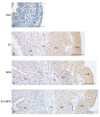Modulation of small leucine-rich proteoglycans (SLRPs) expression in the mouse uterus by estradiol and progesterone
- PMID: 21294898
- PMCID: PMC3041739
- DOI: 10.1186/1477-7827-9-22
Modulation of small leucine-rich proteoglycans (SLRPs) expression in the mouse uterus by estradiol and progesterone
Abstract
Background: We have previously demonstrated that four members of the family of small leucine-rich-proteoglycans (SLRPs) of the extracellular matrix (ECM), named decorin, biglycan, lumican and fibromodulin, are deeply remodeled in mouse uterine tissues along the estrous cycle and early pregnancy. It is known that the combined action of estrogen (E2) and progesterone (P4) orchestrates the estrous cycle and prepares the endometrium for pregnancy, modulating synthesis, deposition and degradation of various molecules. Indeed, we showed that versican, another proteoglycan of the ECM, is under hormonal control in the uterine tissues.
Methods: E2 and/or medroxiprogesterone acetate (MPA) were used to demonstrate, by real time PCR and immunoperoxidase staining, respectively, their effects on mRNA expression and protein deposition of these SLRPs, in the uterine tissues.
Results: Decorin and lumican were constitutively expressed and deposited in the ECM in the absence of the ovarian hormones, whereas deposition of biglycan and fibromodulin were abolished from the uterine ECM in the non-treated group. Interestingly, ovariectomy promoted an increase in decorin, lumican and fibromodulin mRNA levels, while biglycan mRNA conspicuously decreased. Hormone replacement with E2 and/or MPA differentially modulates their expression and deposition.
Conclusions: The patterns of expression of these SLRPs in the uterine tissues were found to be hormone-dependent and uterine compartment-related. These results reinforce the existence of subpopulations of endometrial fibroblasts, localized into distinct functional uterine compartments, resembling the organization into basal and functional layers of the human endometrium.
Figures








Similar articles
-
Small leucine-rich proteoglycans (SLRPs) in uterine tissues during pregnancy in mice.Reproduction. 2003 Apr;125(4):585-95. doi: 10.1530/rep.0.1250585. Reproduction. 2003. PMID: 12683929
-
Colocalization of the collagen-binding proteoglycans decorin, biglycan, fibromodulin and lumican with different cells in human gingiva.J Periodontal Res. 2005 Feb;40(1):73-86. doi: 10.1111/j.1600-0765.2004.00776.x. J Periodontal Res. 2005. PMID: 15613083
-
Localization of small leucine-rich proteoglycans and transforming growth factor-beta in human oral mucosal wound healing.Wound Repair Regen. 2008 Nov-Dec;16(6):814-23. doi: 10.1111/j.1524-475X.2008.00435.x. Wound Repair Regen. 2008. PMID: 19128253
-
Proteoglycans and diseases of soft tissues.Adv Exp Med Biol. 2014;802:49-58. doi: 10.1007/978-94-007-7893-1_4. Adv Exp Med Biol. 2014. PMID: 24443020 Review.
-
Molecular cues for immune cells from small leucine-rich repeat proteoglycans in their extracellular matrix-associated and free forms.Matrix Biol. 2023 Nov;123:48-58. doi: 10.1016/j.matbio.2023.10.001. Epub 2023 Oct 2. Matrix Biol. 2023. PMID: 37793508 Free PMC article. Review.
Cited by
-
ADAMTS-1, a multifunctional proteinase, in the uterus of both estrous cycle rats and ovariectomized rats can be regulated via hormones.Histochem Cell Biol. 2025 Jun 3;163(1):62. doi: 10.1007/s00418-025-02382-5. Histochem Cell Biol. 2025. PMID: 40461860 Free PMC article.
-
Knockdown of Lumican Inhibits Proliferation and Migration of Bladder Cancer.Transl Oncol. 2019 Aug;12(8):1072-1078. doi: 10.1016/j.tranon.2019.05.014. Epub 2019 Jun 6. Transl Oncol. 2019. PMID: 31176992 Free PMC article.
-
Decorin induced by progesterone plays a crucial role in suppressing endometriosis.J Endocrinol. 2014 Nov;223(2):203-16. doi: 10.1530/JOE-14-0393. Epub 2014 Sep 22. J Endocrinol. 2014. PMID: 25244916 Free PMC article.
-
lncRNA FDNCR promotes apoptosis of granulosa cells by targeting the miR-543-3p/DCN/TGF-β signaling pathway in Hu sheep.Mol Ther Nucleic Acids. 2021 Mar 1;24:223-240. doi: 10.1016/j.omtn.2021.02.030. eCollection 2021 Jun 4. Mol Ther Nucleic Acids. 2021. PMID: 33767918 Free PMC article.
-
Estradiol induces transcriptional and posttranscriptional modifications in versican expression in the mouse uterus.J Mol Histol. 2013 Apr;44(2):221-9. doi: 10.1007/s10735-012-9476-1. Epub 2012 Dec 28. J Mol Histol. 2013. PMID: 23271141 Free PMC article.
References
-
- Allen E. The oestrous cycle in the mouse. Am J Anat. 1927;30:297–371. doi: 10.1002/aja.1000300303. - DOI
Publication types
MeSH terms
Substances
LinkOut - more resources
Full Text Sources
Other Literature Sources
Miscellaneous

